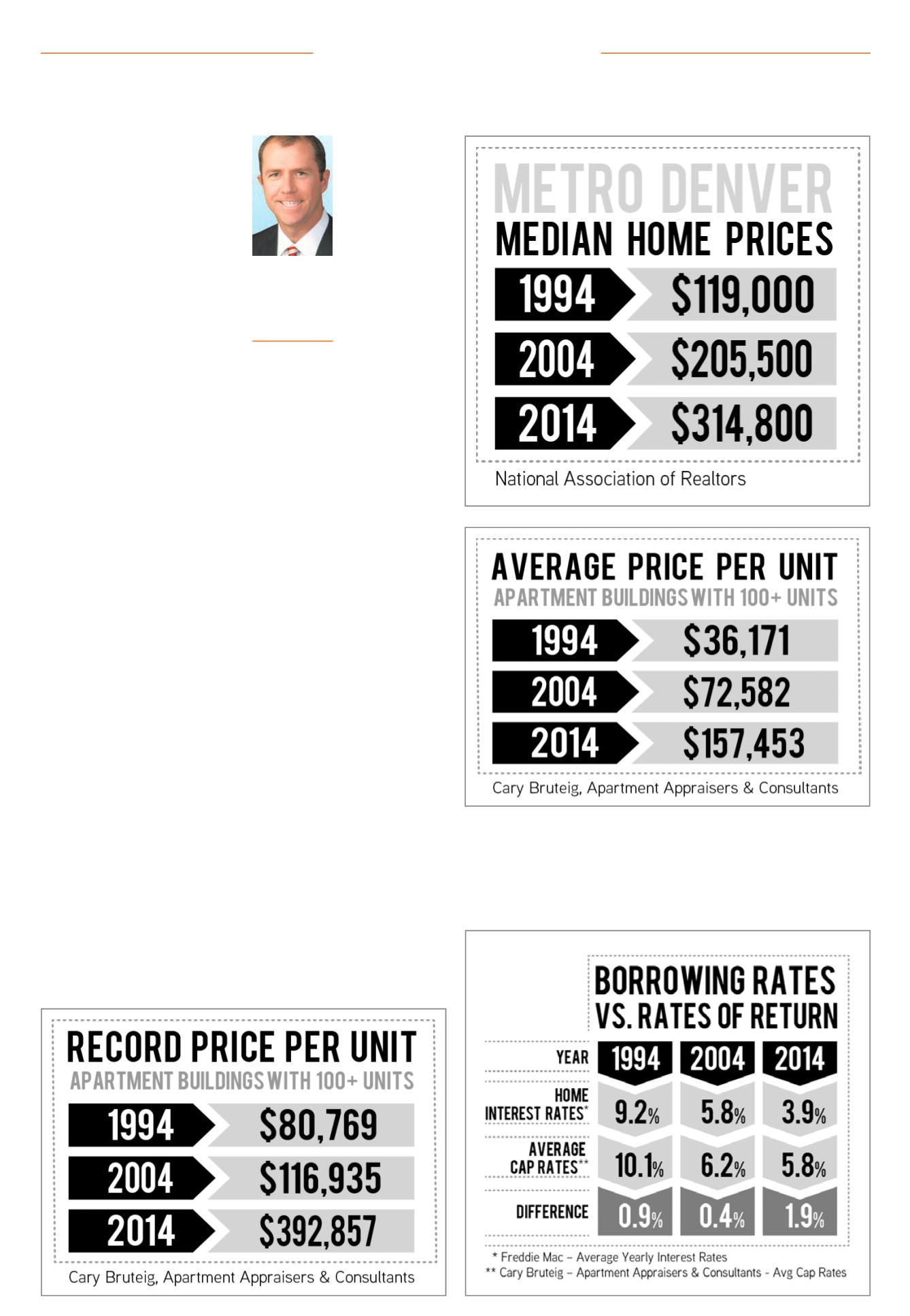

April 2015 — Multifamily Properties Quarterly —
Page 5
I
t seems a little hard to imagine
that we could be reading a head-
line like this in the future about
home prices in Denver. However,
if we look back 20 years, we can
see that median home prices went up
2.65 times from 1994 to 2014. If you
apply this same rate of appreciation to
year-end 2014 median home price, you
could forecast home prices to exceed
$830,000 in 20 years.
As is said, “Past performance is
not an indicator of future outcomes,”
and obviously this methodology is a
bit oversimplified, but it provides an
entertaining way to take a guess at
what the future could hold.
Apartments – A Look Back
When looking at historic average
apartment sales for properties with
100 units or more in those same time
periods, the rate of appreciation is even
more striking with the average price
per unit increasing 4.35 times from
1994 to 2014.
The average price per unit does not
account for the age of the property,
amenities, property upgrades and so
forth.These factors have a bearing on
values, especially if you consider the
record-level pricing achieved by newer
properties with incredible amenities
in core locations. For example, if we
look at record-setting sales in terms
of the highest price per unit each year
for apartments sold with 100 units or
more, we can see the difference – the
record sale price per unit increased by
4.86 times from 1994 to 2014.
If this rate of appreciation were to
occur again over the next 20 years we
could see a record-breaking price per
unit of over $1.9 million! That seems
really hard to envision, but I recall a
conversation with a client back in the
early 2000s. He purchased apartments
in Capitol Hill 10 years prior for $15,000
per unit, and he didn’t think that in his
life they would be worth over $50,000
per unit. This client is still very much
alive today and we have seen proper-
ties similar to his sell for over $125,000
per unit.
Historic Returns
Capitalization rates represent the
rate of return an investor is expect-
ing based on the purchase price. The
percent is derived by dividing net oper-
ating income by the purchase price.
A higher cap rate indicates a higher
rate of return. Further, the greater the
difference between the cap rates and
mortgage rates indicates better invest-
ment returns after debt service. By
looking at the difference between aver-
age cap rates and mortgage interest
rates it would appear that leveraged
buyers have a more
positive spread of
1.9 percent in 2014,
compared with 0.9
percent in 1994.
Recession Proof?
This macro view
of historical values
might belie the
fact that the mar-
ket weathered two
major recessions
in the last 20 years
– first around 2001
with the dot-com
bust, and again
in 2008 with the
financial markets meltdown. It might
also be somewhat misleading to think
that everyone who bought real estate
over the last 20 years made money
(because real estate always goes up in
value, right?). After the fallout from the
recession in 2008 we witnessed several
apartment buildings become lender-
owned from owners who purchased
the properties between 2005-2007.
Interestingly, we recently valued a
property for a lender who foreclosed
during the end of the recession and
has been managing the asset since
that time. At one point the lender was
facing a significant loss. Now, based on
the current restabilized operations, the
property is worth significantly more
than what the previous owner paid for
it in 2007.We tend not to think of real
estate gaining or losing value quickly
but, as recent history shows, it can
happen.
Predictions
We remain very bullish on the near-
term apartment market due the posi-
tive make up of a growing generation
of millennial and empty-nester rent-
ers, lack of for-sale housing options,
strong in-migration to Colorado and a
steadily growing employment market.
However, forecasting what the real
estate market will do in the near
term is always difficult. Will a Euro-
pean debt crisis stymie the market?
Will interest rates increase rapidly?
When will the next “black swan”
event occur? These game-changing
events that tend to send demand
from renters and apartment inves-
tors to the sidelines usually occur
suddenly and without much warn-
ing. Those who can avoid selling into
these markets likely will enjoy the
long-term upside similar to what we
have seen over the last 20 years.
We know that in the current mar-
ket with record-high rents, low bor-
rowing costs and strong investor
demand, it is an excellent time to be
a seller and an owner. Looking into
the past over the long term paints a
pretty good picture of steady overall
apartment appreciation. With our
biased love of Denver and all that
Colorado has to offer, we remain very
positive on this market for the long
term. Here’s to seeing a record price-
per-unit sale in 2034 of $1.9 million!
In the meantime, enjoy these
record rent increases and record prof-
its. And to those waiting to buy in the
next cycle, please let me know when
it will be coming.
s
Median home prices surpass $830,000 in 2034Denver Metro Update
Craig Stack
Vice president,
Colliers
International
Multifamily
Advisory Group,
Denver
















